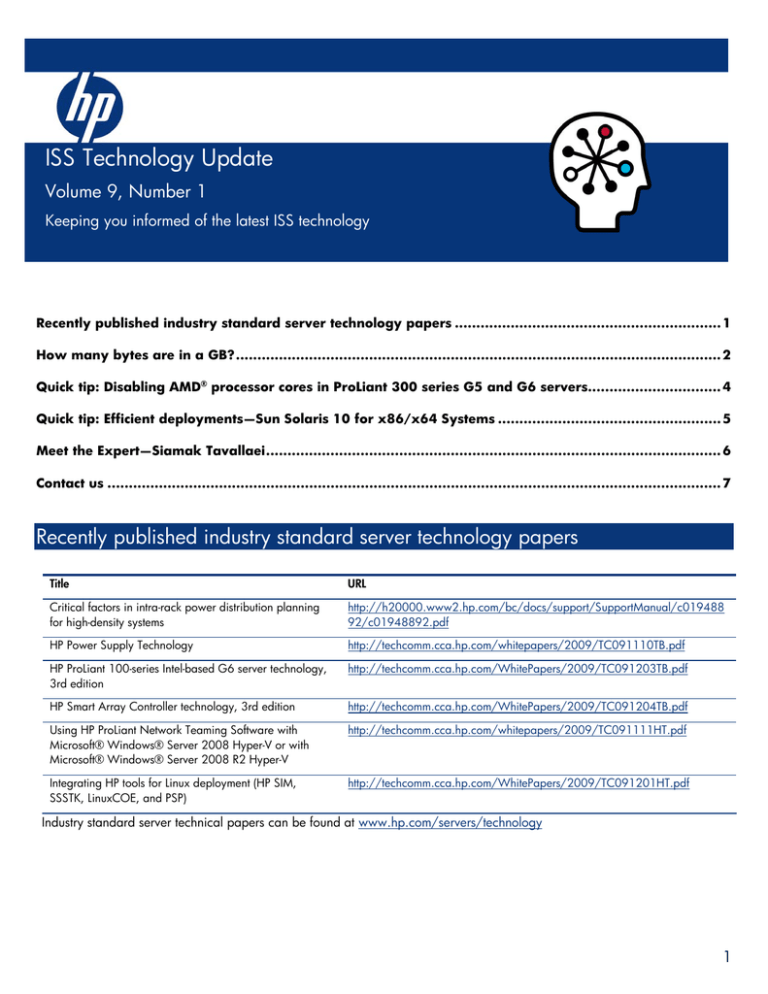
ISS Technology Update
Volume 9, Number 1
ISS Technology Update
Volume 9, Number 1
Keeping you informed of the latest ISS technology
Recently published industry standard server technology papers .............................................................. 1
How many bytes are in a GB?................................................................................................................. 2
Quick tip: Disabling AMD® processor cores in ProLiant 300 series G5 and G6 servers............................... 4
Quick tip: Efficient deployments—Sun Solaris 10 for x86/x64 Systems .................................................... 5
Meet the Expert—Siamak Tavallaei.......................................................................................................... 6
Contact us ............................................................................................................................................... 7
Recently published industry standard server technology papers
Title
URL
Critical factors in intra-rack power distribution planning
for high-density systems
http://h20000.www2.hp.com/bc/docs/support/SupportManual/c019488
92/c01948892.pdf
HP Power Supply Technology
http://techcomm.cca.hp.com/whitepapers/2009/TC091110TB.pdf
HP ProLiant 100-series Intel-based G6 server technology,
3rd edition
http://techcomm.cca.hp.com/WhitePapers/2009/TC091203TB.pdf
HP Smart Array Controller technology, 3rd edition
http://techcomm.cca.hp.com/WhitePapers/2009/TC091204TB.pdf
Using HP ProLiant Network Teaming Software with
Microsoft® Windows® Server 2008 Hyper-V or with
Microsoft® Windows® Server 2008 R2 Hyper-V
http://techcomm.cca.hp.com/whitepapers/2009/TC091111HT.pdf
Integrating HP tools for Linux deployment (HP SIM,
SSSTK, LinuxCOE, and PSP)
http://techcomm.cca.hp.com/WhitePapers/2009/TC091201HT.pdf
Industry standard server technical papers can be found at www.hp.com/servers/technology
1
ISS Technology Update
Volume 9, Number 1
How many bytes are in a GB?
Storage device manufacturers and operating system developers answer this question differently. This is the reason why a
number of lawsuits have sprung up around the country, typically between storage device manufacturers and disgruntled
customers. For example, the capacity of a 300,000,000,000 byte drive is reported as 300 GB by storage device
manufacturers but is often reported as 279.4 GB or 286,102 MB by the OS. The variation stems from different interpretations
of the “prefixes” G and M.
Prefixes are the set of letters that precede units such as “bit” (b) and “byte” (B). The computing industry uses prefixes like kilo
(k), mega (M), giga (G), and tera (T) to describe disk storage capacity, file size, memory size, and data transmission rates (10
Gigabit Ethernet, 6 Gb/s SAS). The prefixes k, M, G, and T are from the International System of Units (SI), and they are
defined as powers of ten: 103, 106, 109, and 1012, respectively. In many instances, however, the computer industry has
erroneously used these SI decimal prefixes to quantify binary multiples, which are based on powers of two: 210, 220, 230, and
240 (see the note “How it started”). The error, and resulting confusion, due to the incorrect use of SI decimal prefixes for binary
multiples becomes more significant for larger multiples (see Table 1-1).
Disk drive manufacturers correctly use SI prefixes and power of ten values because drive capacity is not intrinsically a power of
two. Although drive capacity is a multiple of 512 bytes (n29), it is not restricted to being 2n bytes. Software often reports drive
and file capacity by misusing SI prefixes with power of two values. This difference has resulted in lawsuits against some storage
product manufacturers since the OS may report the capacity of a 300 GB drive as "279.4 GB". To protect against legal
action, manufacturers typically include unnecessary disclaimers such as "When referring to hard drive capacity, one gigabyte,
or GB, equals one billion bytes and one terabyte, or TB, equals one trillion bytes."
Table 1-1. The difference (error) between decimal and binary is more significant as binary multiples increase.
Correct SI usage
Factor
Name
Incorrect binary usage
Prefix
Value
Factor
103
1,000
106
Error
Value
kilo
k
210
1,024
2%
1,000,000
mega
M
220
1,048,576
5%
109
1,000,000,000
giga
G
230
1,073,741,824
7%
1012
1,000,000,000,000
tera
T
240
1,099,511,627,776
10%
1015
1,000,000,000,000,000
peta
P
250
1,125,899,906,842,624
13%
1018
1,000,000,000,000,000,000
exa
E
260
1,152,921,504,606,846,976
15%
1021
1,000,000,000,000,000,000,000
zetta
Z
270
1,180,591,620,717,411,303,424
18%
1024
1,000,000,000,000,000,000,000,000
yotta
Y
280
1,208,925,819,614,629,174,706,17
6
21%
How it started
The size of a byte—the smallest amount of data a computer can access at once—is hardware dependent. The
modern de facto standard of 8 bits per byte is partly due to the IBM System/360 architecture introduced in the
1960s and the 8-bit microprocessors introduced in the 1970s. The IBM System/360 team was the first to
misuse SI prefixes to describe RAM capacity. They used the value "32k" to describe 321024 bits because it
was approximately 321000.
New binary prefixes
In 1998, the standards organization International Electrotechnical Commission (IEC) adopted new prefixes for binary powers
based on recommendations by the International Union of Pure and Applied Chemistry (IUPAC) and the National Institute of
Standards and Technology (NIST). The binary prefixes are defined in the international standard IEC 60027-2:2005, third
2
ISS Technology Update
Volume 9, Number 1
edition, Letter symbols to be used in electrical technology – Part 2: Telecommunications and electronics. Table 1-2 lists the
names and symbols for the adopted binary prefixes. Pronounce the first two letters in each symbol like the corresponding SI unit
followed by "bi" (short for binary, but pronounced "bee"). For example, one kibibyte (pronounced ki-bee-byte) is written as
1 KiB = 210 B = 1024 B.
Table 1-2. Binary prefixes adopted by the IEC
Factor
Value
Name
Symbol
210
1,024
kibi
Ki
220
1,048,576
mebi
Mi
230
1,073,741,824
gibi
Gi
240
1,099,511,627,776
tebi
Ti
250
1,125,899,906,842,624
pebi
Pi
260
1,152,921,504,606,846,976
exbi
Ei
270
1,180,591,620,717,411,303,424
zebi
Zi
280
1,208,925,819,614,629,174,706,176
yobi
Yi
Reprinted with permission of the IEC (see Legal Notices).
Reducing the confusion
To reduce confusion, vendors are pursuing one of two remedies: they are changing SI prefixes to the new binary prefixes, or
they are recalculating the numbers as powers of ten.
For disk and file capacities, the latter remedy is more popular because it is much easier to recognize that 300 GB is the same
as 300,000 MB than to recognize that 279.4 GiB is the same as 286,102 MiB. For example, in 2009, the SourceForge web
site reported file sizes using binary prefixes for several months before changing back to SI prefixes but switching the file sizes to
powers of ten.
For memory capacities, binary prefixes are more natural. For example, reporting a Smart Array controller cache size of
512 MiB is preferable to reporting it as 536.9 MB.
HP is considering modifying its storage utilities to report disk capacity with correct decimal and binary values side-by-side (for
example, "300 GB (279.4 GiB)"), and report cache sizes with binary prefixes ("1 GiB"). Let us know what you think. Provide
your comments to the HP Reality Check: Server Insights blog at http://www.communities.hp.com/online/blogs/reality-checkserver-insights/default.aspx.
Additional resources
For additional information on the topics discussed in this article, visit the following sites:
Resource
URL
SI prefixes
http://www.bipm.org/en/si/si_brochure/chapter3/prefixes.html
IEC article : Prefixes for binary multiples
http://www.iec.ch/zone/si/si_bytes.htm
Binary prefixes
http://en.wikipedia.org/wiki/Binary_prefix
3
ISS Technology Update
Volume 9, Number 1
Quick tip: Disabling AMD® processor cores in ProLiant 300 series G5 and G6
servers
In ProLiant AMD 300-series G5 and G6 servers, RBSU options are available to disable processor cores. Operating systems and
applications can recognize the reduced core count so that fewer software licenses may be required. Reducing core count
recognition has the potential to reduce software licensing costs. Also, applications can benefit from increased memory
bandwidth and increased cache per core. The mechanisms and options to disable processor cores vary depending on the
installed AMD or Intel processor and whether the HP ProLiant server is Generation 5 or 6.
This article describes the available options to disable cores on ProLiant AMD 300 series (the option to disable cores is not
supported on ProLiant AMD 100 series servers) G5 and G6 servers using HP Core Disable technology and AMD Core Select
technology™.
HP Core Disable technology
For HP ProLiant G5 servers using earlier models of the AMD processor (2300/8300 series), the RBSU offers a core disable
option based on HP Core Disable technology. With this technology, the user can configure the server such that all cores are
enabled or half the cores are enabled (see Table 1). The option to enable only one core is not present in the currently released
BIOS updates.
HP Note
The lack of support for single-core operation is based on observations with Systems ROMPaq Firmware
Upgrade for HP ProLiant DL385 G5 (A09) Servers Version: 2009.07.11 (A) (11 Sep 2009).
AMD Core Select technology
AMD Core Select is offered on HP ProLiant G6 servers that are configured with an AMD 2400 or 8400 series processor and
the latest System ROM supporting this feature. AMD Core Select lets administrators use the RBSU to select the number of
software-visible cores per CPU. This selection range includes a minimum of one, up to the full number of supported cores as
shown in Table 1.
Table 1. HP Core Disable and AMD Core Select support in ProLiant AMD G5 and G6 servers
Server Platform
Technology
AMD Processor
Core options
ProLiant AMD G5
HP Core Disable
2300/8300 series
ProLiant AMD G6
AMD Core Select
2400/8400 series
All cores enabled
1/2 cores enabled
All cores enabled
5 cores enabled
4 cores enabled
3 cores enabled
2 cores enabled
1 cores enabled
Additional resources
For additional information on the topics discussed in this article, visit the following sites:
Resource
URL
Technology and architecture of HP ProLiant AMDbased 300-series G6 (Generation 6) servers
http://h20000.www2.hp.com/bc/docs/support/SupportManual
/c01889304/c01889304.pdf?jumpid=reg_R1002_USEN
4
ISS Technology Update
Volume 9, Number 1
Quick tip: Efficient deployments—Sun Solaris 10 for x86/x64 Systems
To successfully deploy Sun Solaris 10 for x86/x64 on HP ProLiant Servers, thoroughly read the following documentation:
The Deployment Guide for HP ProLiant Servers Sun Solaris 10 for x86/x64 Systems, which is available at
http://h20000.www2.hp.com/bc/docs/support/SupportManual/c01153970/c01153970.pdf?jumpid=reg_R1002_USEN.
The user guide appropriate for your HP Smart Array controller, available at
http://h18004.www1.hp.com/products/servers/proliantstorage/arraycontrollers/documentation.html?jumpid=reg_R1002_
USEN.
IMPORTANT:
Using ProLiant technologies and applying Solaris deployment mechanisms to ProLiant servers
involves complex technologies. If questions arise during the deployment, record the questions
and research them after the deployment completes. During the deployment, carefully follow the
processes outlined in the deployment guide. To successfully configure these technologies, you
must follow the deployment guide carefully and completely.
Common issues
The following two issues commonly arise during deployment:
Entering commands and creating configuration files—When typing long command-line strings or manually creating
configuration files, make sure to follow the syntax exactly as shown in the deployment guide. The commands and files must
be typed precisely as shown.
Drivers not available on the Solaris media—The Smart Array driver and the Broadcom NetXtreme II network driver are not
included on the Solaris media. These drivers must be available on the system during the operating system installation as
follows:
– When installing to disks attached to a Smart Array controller, the miniroot must have the array driver so that the Solaris
software can be installed onto the disks. See the deployment guide for information on installing the Smart Array driver,
cpqary3, into the miniroot.
– For network-based deployments, the miniroot must have a driver before the network interface can be used. See the
deployment guide for information on installing the Broadcom NetXtreme II driver, bnx, into the miniroot.
Before beginning the deployment, review the “Known issues” section of the deployment guide for issues that may occur during
the deployment, particularly the following:
Hard drives not seen after CPQary3 added to miniroot
“No Driver bind” or “No Disks found” message seen after HP drivers are added to the miniroot
Tuning and best practices
The deployment guide does not cover ProLiant tuning for Solaris nor best practices for Solaris Zettabyte File System (ZFS) or
Fault Management Architecture (FMA). For information on tuning and best practices, see the Sun Microsystems BigAdmin
System Resources and Community website at
www.sun.com/bigadmin/home/index.jsp?baMainView=solaris&baSubView=solaris.
5
ISS Technology Update
Volume 9, Number 1
Meet the Expert—Siamak Tavallaei
Siamak Tavallaei, a Distinguished Technologist with HP Industry Standard Servers
(ISS) Platform Architecture and Technology, is a leading HP expert on Intel
processors and chipsets, primarily with HP ProLiant 500 series platforms. His
expertise includes processor architecture, cache coherency, memory sub-systems,
legacy components, fabric/IO interfaces to processor and peripheral components,
and storage and network controllers.
That’s not all. Siamak collaborates externally with customers, technology vendors,
suppliers, and industry partners; he also collaborates internally with product
development and marketing organizations to arrive at optimal solutions that satisfy
customer needs.
Handling such a long list of responsibilities requires exceptional skill. Gene
Freeman, his manager, lauds Siamak’s outstanding analytical ability by saying,
“He can take any subject and break it down to fine levels of detail for careful
analysis.” Gene points out that Siamak is very active in HP ISS Technology Tour
events, HP ISS Technology Exchanges, and the HP ISS Technology Advisory
Council. He also participates with HP Business Critical Systems (BCS) as a solution
architect for mission critical customers, adding his x86 expertise to the Itanium
perspective to help solve customers' difficult problems.
Early lessons pay dividends
Name: Siamak Tavallaei
Title: Distinguished Technologist, HP
Industry Standard Servers
Years at HP: 19
University: MS and BS Electrical
Engineering, Utah State University
BS, Applied Mathematics; BS, Electronics
Engineering Technology, Outstanding
Mathematics Graduate
Weber State University
Siamak and his wife, Linda, have a daughter (11) and a son (7). Siamak
volunteers as a den leader with his son’s Cub Scout pack, where he enjoys
teaching lifelong principles to the cub scouts. Early on, Siamak learned the
principal lessons from his parents and teachers to think, experiment, build, and teach. He observed his father’s meticulous
attention to detail and marveled at his creations. Siamak’s middle school mathematics teacher provoked him to think hard until
his brain got hot. He was fortunate to have science teachers who let him experiment in the physics and chemistry labs; and his
mother encouraged him to share his learning with others.
On the forefront of InfiniBand
Siamak has developed useful innovations into a number of multi-processor ProLiant servers that has led to their successful
production. But one of his career highlights with HP occurred during two years of intense competitive collaboration with industry
leaders to develop the specification for InfiniBand. It required tremendous finesse in balancing technical prowess, company
business needs, social interactions, and leadership within a group of expert volunteers from competing companies.
Solutions driven by customer input
When asked about the role that customer input plays in product development, Siamak said, “Our solutions are mostly driven by
customers’ stated desires, but it is their unstated needs that provide a richer opportunity for innovation. To profitably meet such
requirements, I constantly look for opportunities to adapt existing technologies, to develop new ones, or to invent useful
solutions.”
Collaboration with industry partners
Siamak believes that the strength of HP comes not only from the expertise of its engineers, but also from their interaction with
industry partners. For example, HP participates internationally in over 200 standards organizations through more than 500
technical committees. HP engineers help develop specifications for memory, wired and wireless telecommunications, storage,
management software, information technology and security, ANSI, IEEE, ISO/IEC, and so forth. HP also works closely with
industry partners that develop processors, memory, storage, and networking components.
6
ISS Technology Update
Volume 7, Number 10
Industry standard server technical papers can be found at www.hp.com/servers/technology.
Contact us
Send comments about this newsletter to TechCom@HP.com.
To subscribe to the ISS Technology Update newsletter, click mailto:techcom@hp.com?subject=TechUpdate_subscription
Follow us on Twitter
Legal Notices
© Copyright 2010 Hewlett-Packard Development Company, L.P. The information contained herein is subject to
change without notice. The only warranties for HP products and services are set forth in the express warranty
statements accompanying such products and services. Nothing herein should be construed as constituting an
additional warranty. HP shall not be liable for technical or editorial errors or omissions contained herein.
AMD and AMD Opteron are trademarks of Advanced Micro Devices, Inc.
Intel, Intel Xeon, and Intel Itanium are trademarks of Intel Corporation in the United States and other countries.
Thanks to the International Electrotechnical Commission (IEC) for permission to reproduce information from its
website. All such extracts are copyright of IEC, Geneva, Switzerland. All rights reserved. IEC has no responsibility
for the placement and context in which the extracts and contents are reproduced by the author, nor is IEC in any
way responsible for the other content or accuracy therein”.
TC100102NL
7




